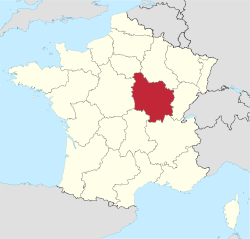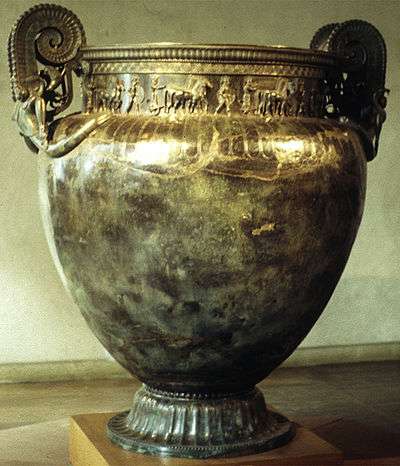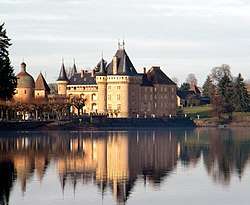Burgundy
Burgundy (/ˈbɜːrɡəndi/; French: Bourgogne [buʁɡɔɲ] (![]()
Burgundy Bourgogne | |
|---|---|
 Flag  Coat of arms | |
 | |
| Coordinates: 47°00′N 4°30′E | |
| Country | |
| Dissolved | 2016-01-01 |
| Prefecture | Dijon |
| Departments | |
| Government | |
| • President | François Patriat (PS) |
| Area | |
| • Total | 31,582 km2 (12,194 sq mi) |
| Population (2008-01-01) | |
| • Total | 1,631,000 |
| • Density | 52/km2 (130/sq mi) |
| Time zone | UTC+01:00 (CET) |
| • Summer (DST) | UTC+02:00 (CEST) |
| ISO 3166 code | FR-D |
| GDP (2012) | Ranked 16th |
| Total | €42.7 billion (US$55.0 bn) |
| Per capita | €25,996 (US$33,436) |
| NUTS Region | FR2 |
| Website | www.xn--rgion-bourgogne-bnb.fr (archive) |
Historically, the name Burgundy has denoted numerous political entities, including kingdoms and duchies spanning territory from the Mediterranean to the Low Countries. Geographically speaking, since the inception of the French departmental system in 1790, the name refers to the geographic area comprising the four departments of Côte-d'Or, Saône-et-Loire, Yonne, and Nièvre.[2]
In 2016 Burgundy and Franche-Comté were merged for administrative purposes into the new region of Bourgogne-Franche-Comté.[3]
History

The first recorded inhabitants of the area that became Burgundy were Celts, who were eventually incorporated into the Roman Empire.
During the 4th century, the Burgundians, a Germanic people, who may have originated in Bornholm (on the Baltic Sea), settled in the western Alps. They founded the Kingdom of the Burgundians, which was conquered in the 6th century by another Germanic tribe, the Franks.

Under Frankish dominion, the Kingdom of Burgundy continued for several centuries.
Later, the region was divided between the Duchy of Burgundy (to the west) and the Free County of Burgundy (to the east). The Duchy of Burgundy is the better-known of the two, later becoming the French province of Burgundy, while the County of Burgundy became the French province of Franche-Comté, literally meaning free county.
Burgundy's modern existence is rooted in the dissolution of the Frankish Empire. In the 880s, there were four Burgundies: the duchy, the county, and the kingdoms of Upper Burgundy and Lower Burgundy.
During the Middle Ages, Burgundy was home to some of the most important Western churches and monasteries, including those of Cluny, Cîteaux, and Vézelay. Cluny, founded in 910, exerted a strong influence in Europe for centuries. The first Cistercian abbey was founded in 1098 in Cîteaux. Over the next century, hundreds of Cistercian abbeys were founded throughout Europe, in a large part due to the charisma and influence of Bernard of Clairvaux. The Abbey of Fontenay, a UNESCO World Heritage site, is today the best-preserved Cistercian abbey in Burgundy. The Abbey of Vezelay, also a UNESCO site, is still a starting point for pilgrimages to Santiago de Compostela.[4] Cluny was almost totally destroyed during the French Revolution.
During the Hundred Years' War, King John II of France gave the duchy to his youngest son, Philip the Bold. The duchy soon became a major rival to the crown. The court in Dijon outshone the French court both economically and culturally. In 1477, at the battle of Nancy during the Burgundian Wars, the last duke Charles the Bold was killed in battle, and the Duchy itself was annexed by France and became a province. However the northern part of the empire was taken by the Austrian Habsburgs.
With the French Revolution in the end of the 18th century, the administrative units of the provinces disappeared, but were reconstituted as regions during the Fifth Republic in the 1970s. The modern-day administrative region comprises most of the former duchy.
Geography
.svg.png)
The region of Burgundy is both larger than the old Duchy of Burgundy and smaller than the area ruled by the Dukes of Burgundy, from the modern Netherlands to the border of Auvergne. Today, Burgundy is made up of the old provinces:
- Burgundy: Côte-d'Or, Saône-et-Loire, and southern half of Yonne. This corresponds to the old duchy of Burgundy (later called province of Burgundy). However, the old county of Burgundy (later called province of Franche-Comté) is not included inside the Burgundy region, but it makes up the Franche-Comté region. Also, a small part of the duchy of Burgundy (province of Burgundy) is now inside the Champagne-Ardenne region.
- Nivernais: now the department of Nièvre.
- the northern half of Yonne is a territory that was not part of Burgundy (at least not since the 11th century), and was a frontier between Champagne, Île-de-France, and Orléanais, being part of each of these provinces at different times in history.
Major communities

Climate
The climate of this region is essentially oceanic (Cfb in Köppen classification), with a continental influence (sometimes called a "half-continental climate").
Politics
The regional council of Burgundy was the legislative assembly of the region, located in the capital city Dijon at 17 boulevard de la Trémouille until its merger to form the regional council of Bourgogne-Franche-Comté.
Culture

Burgundy is one of France's main wine-producing areas. It is well known for both its red and white wines, mostly made from Pinot noir and Chardonnay grapes, respectively, although other grape varieties can be found, including Gamay, Aligote, Pinot blanc, and Sauvignon blanc. The region is divided into the Côte-d'Or, where the most expensive and prized Burgundies are found, and Beaujolais, Chablis, the Côte Chalonnaise and Mâcon. The reputation and quality of the top wines, together with the fact that they are often produced in small quantities, has led to high demand and high prices, with some Burgundies ranking among the most expensive wines in the world.[5]
With regard to cuisine, the region is famous for Dijon mustard, Charolais beef, Bresse chicken, the Burgundian dishes coq au vin and beef bourguignon, and époisses cheese.[6]
Tourist sites of Burgundy include the Rock of Solutré, the Hospices de Beaune, the Ducal Palace in Dijon, and many Renaissance and medieval châteaus, castles, churches and abbeys.[7]
Earlier, the southeastern part of Burgundy was heavily industrial, with coal mines near Montceau-les-Mines and iron foundries and crystal works in Le Creusot. These industries declined in the second half of the twentieth century.
References
- Poupardin, René, Chisholm, Hugh, ed. (1911). . Encyclopædia Britannica (11th ed.). Cambridge University Press.
- Masson, Jean-Louis (1984). "Provinces, départements, régions: L'organisation administrative de la France d'hier à demain" (in French). Éditions Fernand Lanore. p. 201website= Google Livres (French Google Books site). Retrieved 23 May 2020.
- "LOI n° 2015-29 du 16 janvier 2015 relative à la délimitation des régions, aux élections régionales et départementales et modifiant le calendrier électoral". Legifrance (in French). Secrétariat général du Gouvernement. Retrieved 20 May 2020.
- "Burgundy". Paris Digest. 2018. Retrieved 10 August 2018.
- https://www.visitfrenchwine.com/en/vineyard/visit-the-vineyards-of-bourgogne-wine-tourism
- https://us.france.fr/en/news/article/burgundy
- http://ee.france.fr/en/discover/burgundy-5
Further reading
| Wikisource has the text of the 1911 Encyclopædia Britannica article Burgundy. |
- Lecomte, Bernard; Thouart, Jean-Louis (2004). Burgundy, What a Story! (de Bourogne ed.). ISBN 978-2-902650-02-6.CS1 maint: ref=harv (link)
- Davies, Norman (2011). "Ch.3 : Burgundia: Five, Six or Seven Kingdoms (c. 411-1795)". Vanished Kingdoms: The History of Half-Forgotten Europe. London: Allan Lane. ISBN 978-0-141-04886-4.
- Loi n° 2015-29 du 16 janvier 2015 relative à la délimitation des régions, aux élections régionales et départementales et modifiant le calendrier électoral (in French)
- INSEE. "Produits intérieurs bruts régionaux et valeurs ajoutées régionales de 1990 à 2012". Retrieved 4 March 2014.
External links



- (in English) Burgundy : history in the open air—Official French website
- (in French) Burgundy statistics on INSEE website
- (in French) Regional Council website
- (in English) Short guide to Burgundy with main tourist attractions
- (in English) Burgundy at Curlie
- . Catholic Encyclopedia. 1913.



